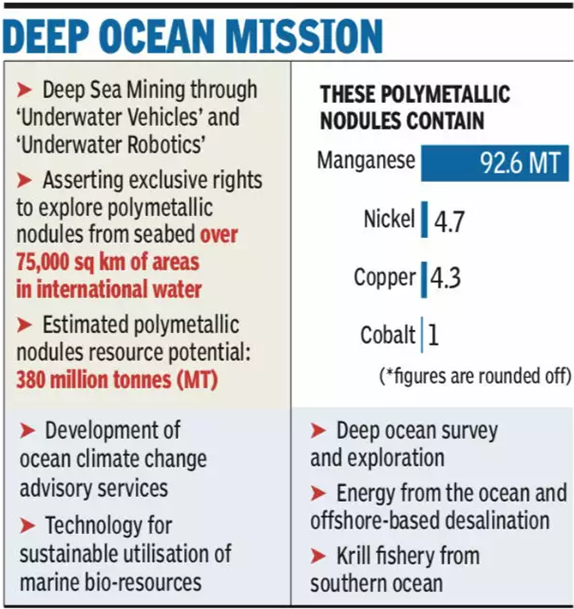Monday, 16th January 2023
China’s ‘chunyun’, the largest annual migration:
Context: Considered the largest annual human migration across the world, “chunyun” was celebrated recently in China.
What is ‘Chunyan’?
‘Chunyun’ simply refers to the celebrations for the Lunar New Year.
- "Chunyun" is a term used in China to describe the period of time around Chinese New Year (also known as Spring Festival), when millions of people travel to their hometowns to be with their families.
- This period of time is known for being one of the busiest travel times of the year in China, with many people taking trains, buses, and airplanes to get to their destinations.
- The exact dates of Chunyun vary each year, but it typically lasts for around 40 days, starting 15 days before the Chinese New Year and ending around 25 days after it.

How will the Spring Festival travel rush impact China’s COVID-19 situation?
- The situation in China is worrisome, with a surge in infections and hospitalisation in major cities in the last few months.
- The upcoming Lunar Year festivities and travel rush have added to the growing anxiety as the country braces for further spread of the virus following the abrupt end of its stringent zero-COVID policy.
Concerns and Criticism:
- The vast elderly Chinese population is at a higher risk since their vaccination coverage remains poor.
- Government data shows that while the overall vaccination rate in China is above 90%, the rate for adults who have taken booster shots stands at 57.9%, dropping to 42.3% for those aged 80 and above.
- The World Health Organisation also recently criticised the handling of the pandemic in China, and said delayed data on new COVID hospitalisations showed a nearly 50% increase since January 1.
Restrictions on travellers from China:
- Over a dozen countries have imposed mandatory COVID tests for travellers from China.
- These include India, the U.S., Japan, Italy and Taiwan.
|
The Chinese Lunar New Year: The Chinese Lunar New Year, also known as the Spring Festival, is the country’s most widely celebrated festival.
|
Source: The Hindu.
Europe's biggest deposit of rare earth metals found in Sweden:
Context:
Sweden's has found the biggest deposit of rare earth metals in Europe.
- The deposit is located in the north of the country and contains neodymium and praseodymium. These metals are used in the production of electric vehicles and wind turbines.
Significance:
The deposit is estimated to contain around 80,000 tonnes of the metals. The discovery of this deposit is significant as it reduces the reliance on China which currently dominates global production of rare earth metals.
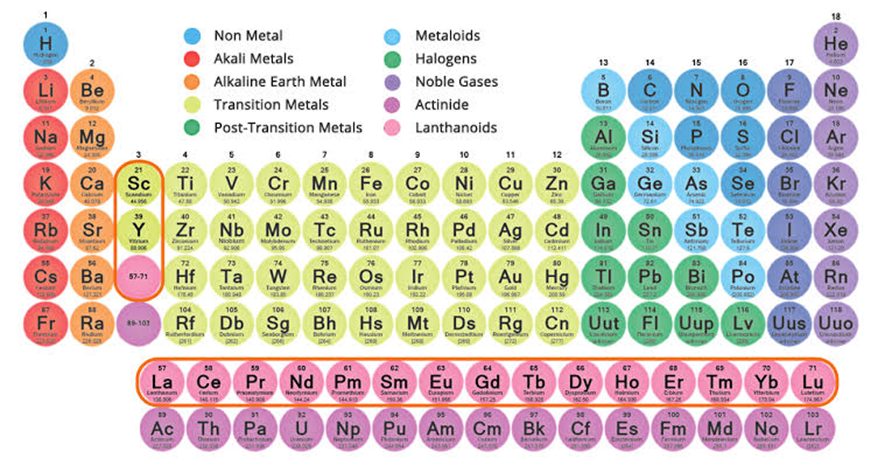
What are Rare Earth Metals?
Rare earth metals are a group of 17 chemical elements in the periodic table, specifically the 15 lanthanides plus scandium and yttrium. These elements have similar chemical properties and are typically found together in the earth's crust.
They are not as rare as the name implies but they are not as commonly found as other metals.
- They have unique magnetic, luminescent, and electrochemical properties that make them essential in a wide range of technologies such as smartphones, electric vehicles, wind turbines, defense systems, and medical equipment.
- Some of the key rare earth metals are neodymium, dysprosium, and yttrium.
Rare Earth Metals in India:
Though India has 6% of the world’s rare earth reserves, it only produces 1% of global output, and meets most of its requirements of such minerals from China. In 2018-19, for instance, 92% of rare earth metal imports by value and 97% by quantity were sourced from China.
Sources: Indian Express.
James Webb telescope discovers its first Earth-sized exoplanet:
Context: The National Aeronautics and Space Administration (NASA), recently, announced that the James Webb Space Telescope has discovered its first new exoplanet.
Highlights:
- Researchers have labelled the planet as LHS 475 b, and it’s roughly the same size as Earth.
- Located just 41 light-years away, this planet orbits very close to a red dwarf star and completes a full orbit in just two days.
What are exoplanets?
An exoplanet is any planet beyond our solar system. Most orbit other stars, but free-floating exoplanets, called rogue planets, orbit the galactic center and are untethered to any star.
- Size: Exoplanets come in a host of different sizes. They can be gas giants bigger than Jupiter or as small and rocky as Earth.
- Composition: Exoplanets are made up of elements similar to those of the planets in our solar system, but their mixes of those elements may differ. Some planets may be dominated by water or ice, while others are dominated by iron or carbon.
- Temperature: They are also known to have different kinds of temperatures — boiling hot to freezing cold.
- According to NASA, to date, more than 5,000 exoplanets have been discovered.

Why do we study them?
- Studying exoplanets broadens our understanding of other solar systems and helps us piece together information about our own planetary system and origin.
- However, the most compelling reason to learn about them is to find the answer to one of the most profound and thought-provoking questions of humankind — are we alone in this universe?
|
Goldilocks zone:
|
Source: Indian Express.
Disaster management plan for power sector:
Context: The Central Electricity Authority (CEA) has released the Disaster Management Plan (DMP) for the power sector.
- The plan includes measures for dealing with natural disasters such as cyclones, floods, and earthquakes, as well as man-made disasters such as terrorist attacks and cyber threats.
Objective: It seeks to evolve a proactive and integrated approach to strengthen disaster mitigation, preparedness, emergency response, and recovery efforts.
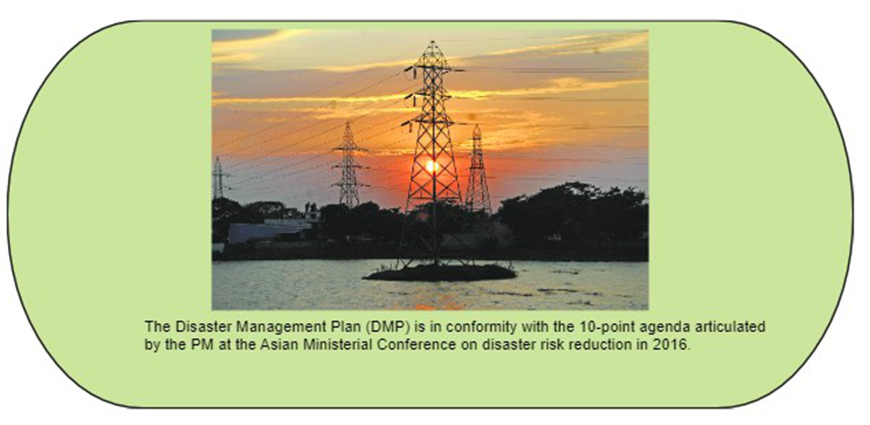
Key points of DMP:
- Framework and direction: The DMP provide a framework and direction to the utilities in the power sector for all phases of the disaster management cycle (Mitigation, Preparedness, Response, and Recovery).
- It is intended to guide all agencies within the sector with a general concept of potential emergencies and roles and assignments before, during, and following emergency situations.
- It includes investing in risk mapping globally, creating a network of universities working on disaster-related issues, leveraging social media and mobile technologies for disaster risk reduction, as well as building local capacities for disaster management, reduction, and relief.
Need for:
- Accurately assessing climate risks is difficult because of the uncertainty in predicting the level and timing of climate threats.
- To estimate threats to power infrastructure, it is pertinent that fragility and vulnerability analysis is carried out for civil structures like buildings and foundations in transmission and distribution facilities.
Significance:
- The DMP will ensure a reliable power supply and quick restoration even in times of extreme weather events and natural disasters.
- This will be helpful for policy and decision-makers to evaluate strategies and measures for critical infrastructure planning and protection.
Source: The Hindu Business line.
UGC nod foreign universities to set up campuses in India:
Context:
Recently, University Grants Commission's (UGC) gives nod foreign universities to set up campuses in India and the initial approval will be for 10 years.
Key points of UGC’s draft regulations:
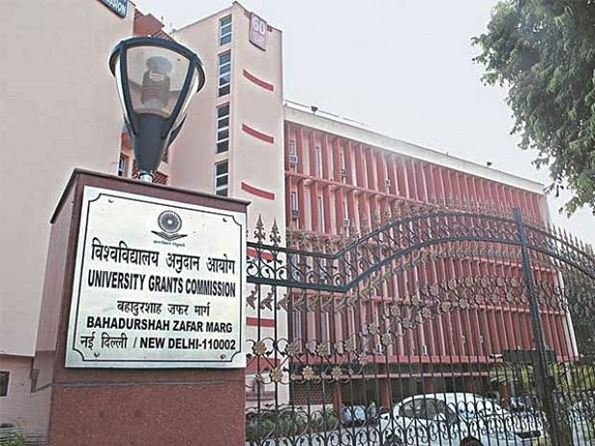
- No online mode: the foreign universities with campuses in the country can only offer full-time programmes in physical mode and not online or distance learning.
- Admission process: These universities will have the freedom to devise their own admission process and fee structure.
- Quality: the foreign universities will also have to ensure the quality of education imparted at their Indian campuses is on par with their main campus.
- Funding: On matters related to funds and funding, the cross-border movement of funds will be according to the Foreign the Exchange Management Act.
- The final norms will be notified by the month's end after taking into account feedback from stakeholders, and the approval granted to foreign varsities will be renewed in the ninth year subject to meeting of certain conditions.
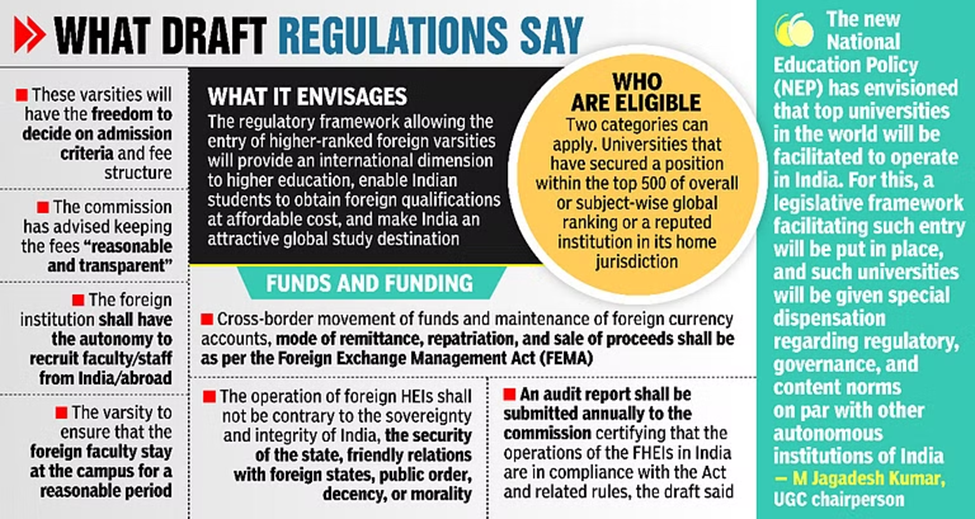
National Education Policy (NEP) on allowing foreign campuses and higher education in the country:
- The National Education Policy (NEP) says that the top 100 universities in the world will be facilitated to operate in India through a legislative framework.
- The NEP talks about creating a legislative framework, while the government is following the regulatory route.
Criticism:
- The UGC draft regulations don’t follow the text of the NEP, rather uses it as a pretext.
- The NEP proposes attracting the top 100 universities, while the UGC draft permits universities with top 500 global rankings or those considered reputed in their home country.
Conclusion:
- The larger goal of the NEP is also to take the gross enrollment ratio (GER) in colleges and universities to 50% by 2035 from the current 27%.
- But chasing online education and private institutions will not benefit those who have no access to education, and merely offer more choices to the upper and middle class who have 100% GER.
Source: Can foreign universities set up campuses in India now? - The Hindu
Financial Services Institutions Bureau:
What is FSIB?
Financial Services Institutions Bureau (FSIB) has been setup as a replacement body of Bank Board Bureau. It was setup in July 2022.
Roles and Functions:
- FSIB has been established as a single entity for making recommendations for appointments of Directors in public sector banks (PSBs), public sector insurers (PSIs) and financial institutions (FIs).
- It will also make recommendations for selection of General Managers and Directors in non-life PSIs.
Composition:
- FSIB will be headed by former Banks Board Bureau Chairman Bhanu Pratap Sharma for two years.
Significance:
FSIB would be a professional body with autonomy in its affairs and shall have its own secretariat.
Background:
The Banks Board Bureau (BBB) has its genesis in the recommendations of ‘The Committee to Review Governance of Boards of Banks in India, May 2014 (Chairman - P. J. Nayak)’.
- The government, in 2016, approved the constitution of the BBB to make recommendations for appointment of whole-time directors as well as non-executive chairpersons of Public Sector Banks (PSBs) and state-owned financial institutions. It was an autonomous recommendation body.

Sources: PIB.
What constitutes the geospatial technology ecosystem?
The geospatial technology ecosystem is a multifaceted entity with multiple interactive components.
- Over the years, the technology ecosystem has evolved to capture the interplay between geospatial technologies, new enabling technologies and business processes to bring with it multitude of opportunities.
- As geospatial technologies get infused with the new age technologies and get embedded into the business processes, they become an enabler for socio-economic development.
Key components of geospatial technology ecosystem:
According to an exclusive study by Geospatial Media and Communication, the geospatial technology ecosystem into four categories:
- GNSS and Positioning.
- GIS and Spatial Analytics.
- Earth Observation.
- 3D Scanning.
Further on, the report sub-categorizes these four technology segments, into hardware, software, and services, providing market size and growth information respectively.
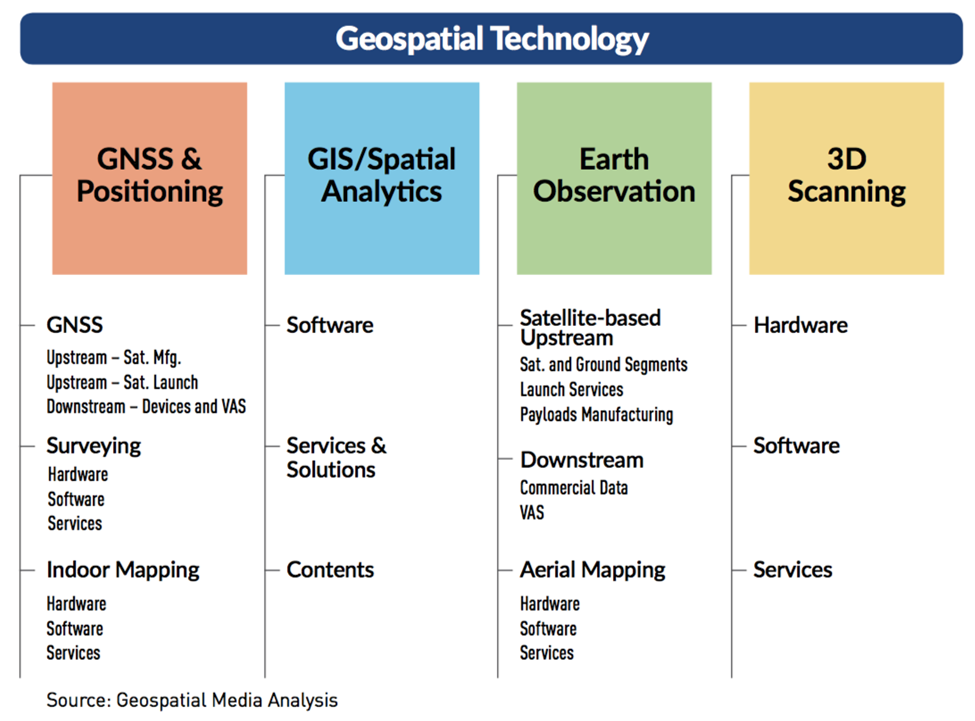
Initiatives started by India:
- Recently, the central government notified the National Geospatial Policy 2022 to strengthen the geospatial sector to support national development, economic prosperity and a thriving information economy.
- Survey of India is proposing a Geospatial Data Processing, Solution development, and Servicing Challenge inviting solutions for select problem statement from these used cases and to foster the adoption of modern geospatial technologies such as cloud, open APIs, Drone based mapping, Sharing and integration of a wide range of data.
Source: PIB geospatialworld.net.
What is the James Webb Space Telescope?
The James Webb Space Telescope is an infrared observatory orbiting the Sun about 1 million miles from Earth to find the first galaxies that formed in the early universe and to see stars forming planetary systems.
NASA announced the launch of the James Webb Space Telescope (JWST) on December 24, 2021.
- Webb was formerly known as the “Next Generation Space Telescope” (NGST) and it was renamed in 2002 after a former NASA administrator, James Webb.
- Webb, the world’s premier space science observatory, will succeed the Hubble Space Telescope, NASA’s flagship telescope that has been in service for more than three decades now.
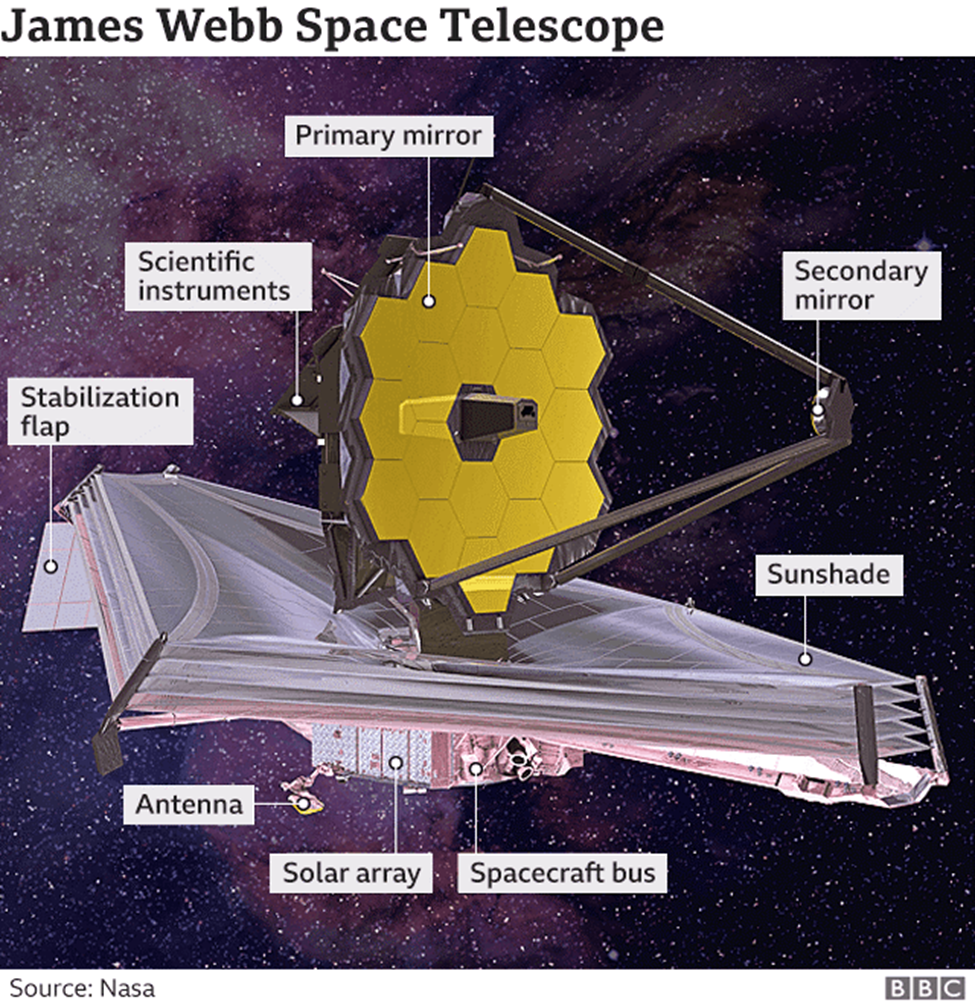
Key features:
- WAVELENGTH: Webb’s four instruments to capture images and spectra of astronomical objects will provide wavelength coverage from 0.6 to 28 microns.
- SIZE: Webb’s primary mirror is approximately 6.5 metres in diameter, giving it a significantly larger collecting area than the mirrors of the current generation of space telescopes.
- ORBIT: Webb will not orbit the Earth, instead it will sit at the Earth-Sun L2 Lagrange point, 1.5 million km away.
Webb Vs Hubble:
- Webb will primarily study the universe in the infrared, while Hubble looks at it mainly at optical and ultraviolet wavelengths.
- Webb’s mirror is much larger than Hubble’s; it can, therefore, look farther back into time than Hubble.
- Also, Hubble is in a much closer orbit around Earth than Webb will be.
Source: NASA.
What are Magellanic Clouds? - Edukemy Current Affairs
Context:
NASA's James Webb telescope, the world's most powerful telescope, has discovered a new star formation in a dynamic cluster located within a nebula 200,000 light years away in the Small Magellanic Cloud (SMC), which is a nearby dwarf galaxy close to the Milky Way with lower metal concentrations. The region, called NGC 346, is considered one of the most dynamic star-forming regions in nearby galaxies.
What are they?
The Magellanic Clouds are two irregular dwarf galaxies that orbit our own Milky Way galaxy.
- They are called the Large Magellanic Cloud (LMC) and the Small Magellanic Cloud (SMC).
- They are named after the explorer Ferdinand Magellan, who observed them during his voyage around the world in the 16th century.
The Magellanic Clouds are significant for several reasons:
- They are the closest galaxies to our own, making them a convenient target for astronomical study.
- They are also relatively small and irregular in shape, which makes them valuable for understanding how galaxies form and evolve.
- Additionally, the Magellanic Clouds are rich in gas and dust, which makes them an excellent place to study star formation.
- They are also important for understanding our own galaxy, the Milky Way. In particular, the Magellanic Clouds are thought to have played a role in shaping the Milky Way's structure and history.
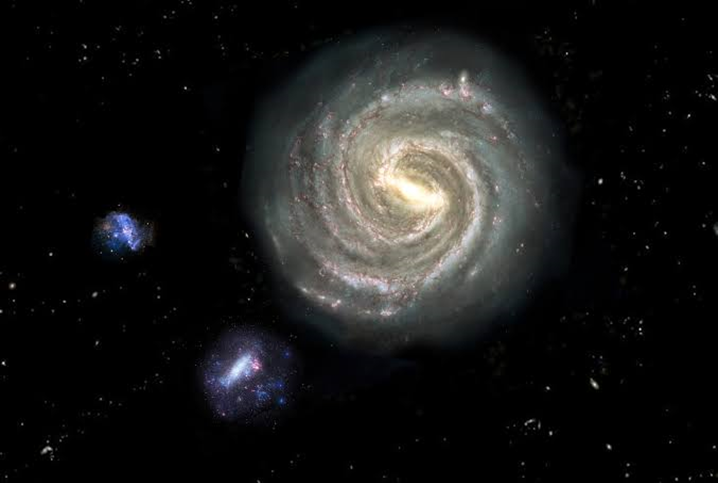
Sources: Livemint.
What is Galactic Halo? - Edukemy Current Affairs
Context:
Astronomers have recently detected in the stellar halo that represents the Milky Way's outer limits a group of stars more distant from Earth than any known within our own galaxy - almost halfway to a neighboring galaxy.
- The Milky Way’s stellar halo is the visible portion of what is more broadly called the galactic halo.
What is Galactic Halo?
The galactic halo is a large, roughly spherical region that surrounds a galaxy, including our own Milky Way. It is composed primarily of old, low-mass stars, as well as dark matter, gas, and other types of stellar debris. The halo is thought to extend out to distances of several hundred thousand light-years from the galactic center, and it is significantly more diffuse than the galaxy's disk.
The galactic halo is significant for several reasons:
- It provides a glimpse into the early history of the galaxy, as the halo stars are among the oldest in the galaxy, and therefore formed in the earliest stages of the galaxy's formation.
- It contains large amounts of dark matter, which is a mysterious form of matter that does not emit or absorb light, but is thought to make up the majority of the matter in the universe.
- It is a source of metal-poor stars, that is, stars that have low concentrations of elements heavier than helium, which are believed to be some of the first stars to have formed in the universe.
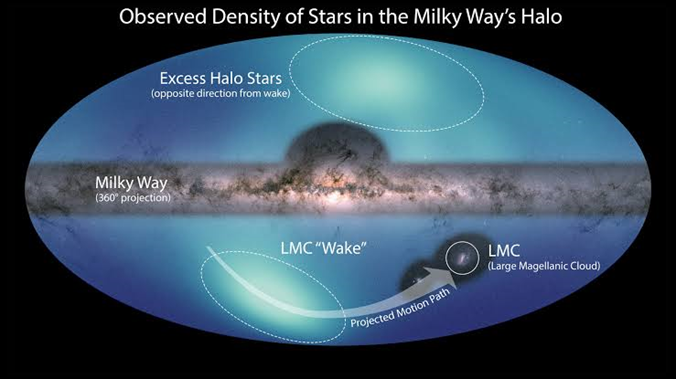
Jagannath Temple - Edukemy Current Affairs
- Context: Recently Odisha Governor supported entry of foreigners to the Puri temple.
- It was built in the 12th Century AD by King Anatavarman Chodaganga Deva of the Eastern Ganga Dynasty.
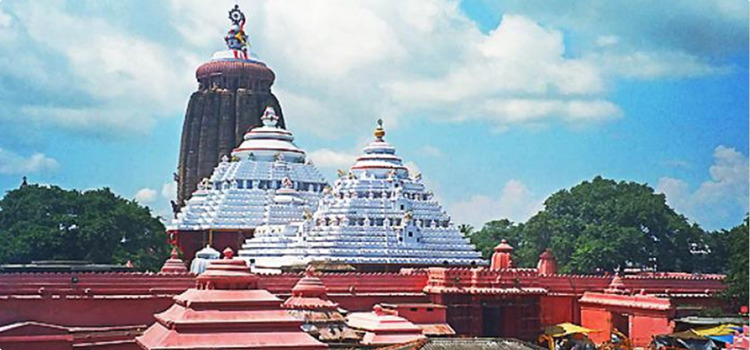
- Four gates
-
- Eastern Singhdwara (main gate with two lions)
- Southern Ashwadwara
- Western Vyaghra Dwara
- Northern Hastidwara
- Other names:
-
- Yamnika Tirtha
- White pagoda
- Architectural features:
-
- The main temple is constructed in such a way that no shadow of the temple falls on the ground at any time of the day.
- The entire temple complex is enclosed within two concentric walls, the Kuruma Bheda (inner wall) and the Meghnad Pachira (Wall).
- The Nilachakra – Or the Blue wheel perched on top of the temple is made of eight metals or asta dhatu.
- The flag or the Patitapabana flows in the opposite direction of the wind.
- The Aruna stambha- the 33 ft monolith structure pillar in front of the Singhadwar of the temple was originally located at the Sun Temple, Konark.
- The idols of the holy trinity are carved out of wood.
- Festivals associated:
-
- Devasnana Purnima
- Chariot Festival
Source:
https://indianexpress.com/article/political-pulse/odisha-governor-pitch-foreigner-entry-jagannath-temple-touches-off-a-row-8382544/
https://odishatourism.gov.in/content/tourism/en/discover/attractions/temples-monuments/jagannath-temple.html
Tongatapu Island - Edukemy Current Affairs
- Context: The island nation of Tonga is still dealing with coastal water damages even after one year of volcanic incident.
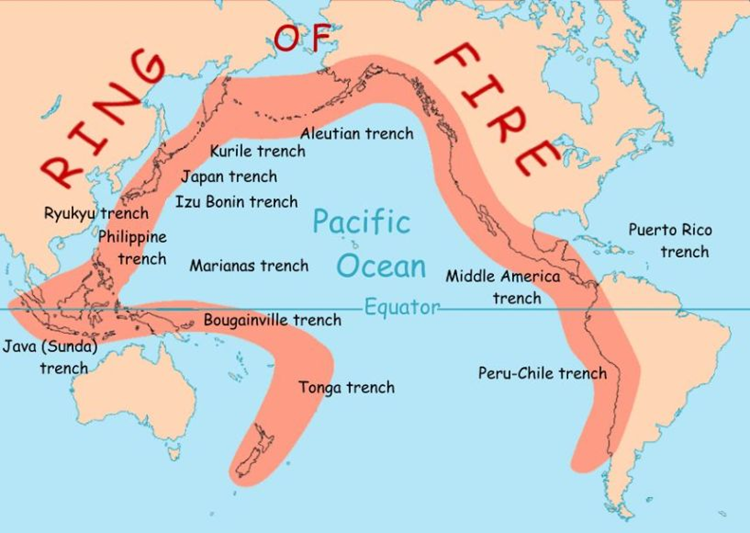
- The Tonga Islands are near the Ring of Fire—an area of heightened volcanic and seismic activity that surrounds the Pacific Ocean basin.
- The Ring of Fire is a Pacific region comprises over 450 volcanoes, including three of the world’s four most active volcanoes
-
- Mount St. Helens the USA
- Mount Fuji Japan
- Mount Pinatubo in the Philippines
- The Ring of Fire, also referred to as the Circum-Pacific Belt, is a path along the Pacific Ocean characterized by active volcanoes and frequent earthquakes.
-
- It extends along the shorelines of the Pacific Ocean, where the Pacific Plate rubs up against other, smaller tectonic plates that make up the Earth's crust, including the Philippine Sea Plate the Cocos, Juan de Fuc, Indian-Australian, Nazca Plates and North American platesthat create the Pacific Ocean's margin.
- From New Zealand to Chile, the 40,000-kilometer horseshoe-shaped ring circumnavigates the globe, passing over the shores of Asia and the Americas.
Source:
https://indianexpress.com/todays-paper/
https://education.nationalgeographic.org/resource/ring-fire
Take a step to regulate deepfakes:
Context:
Not having proper regulations in place for artificial intelligence (AI) technology, particularly with regards to deepfakes, is problematic. Without proper regulations, individuals, companies and even non-state actors can misuse AI, and the lack of clear laws and oversight can lead to negative consequences.
What are deepfakes?
Deepfakes, a term coined to describe the use of artificial intelligence (AI) to create realistic fake videos, have emerged as a major concern in recent times. The technology has advanced to such an extent that it has become increasingly difficult to distinguish between real and fake videos, leading to a proliferation of misinformation and disinformation.
Concerns:
- Deepfakes have the potential to spread misinformation on an unprecedented scale. They can be used to create fake news stories, manipulate public opinion, and even influence elections. This can have a detrimental effect on the functioning of democratic societies, as it undermines the trust in the media and in the political process.
- Deepfake videos can also be used to create targeted disinformation campaigns, for example, by creating fake videos of politicians or public figures to damage their reputation, or to create fake videos of celebrities to exploit them for financial gain.
- Deepfakes are also a serious threat to national security as they can be used to create fake videos of military leaders or to spread false information during a crisis.
The Need for Regulation:
- Given the potential harms associated with deepfakes, it is imperative that India takes steps to regulate them. One of the key challenges in regulating deepfakes is the speed at which the technology is advancing. This requires a dynamic and flexible approach that can adapt to the constantly evolving nature of the technology.
How are they regulated in India?
- Section 500 of the IPC provides punishment for defamation.
- Sections 67 and 67A of the Information Technology Act punish sexually explicit material in explicit form.
What needs to be done?
- One of the first steps in regulating deepfakes should be to put in place a legal framework that criminalizes the creation and dissemination of deepfake videos with the intent to cause harm. This could include penalties for creating and distributing deepfake videos for the purpose of spreading misinformation or for financial gain.
- Another important step in regulating deepfakes is to invest in research and development to improve the ability to detect and mitigate deepfake videos. This could involve developing new technologies, such as video-forensics tools and AI-based systems, to detect deepfake videos and to make it easier for people to verify the authenticity of a video.
- Tech companies also have a critical role to play in regulating deepfakes. They should take steps to detect and remove deepfake videos from their platforms, as well as to develop tools to make it easier for users to verify the authenticity of a video.
Sources: the Hindu.
Soul of Steel challenge: - Edukemy Current Affairs
The Soul of Steel challenge is an initiative aimed at promoting tourism in border areas in India. It was launched recently by the Union Defence Minister.
Details of the Challenge:
- The Soul of Steel expedition is a high-altitude endurance and adventure test in Uttarakhand's Garhwal Himalayas.
- The challenge is open to 12 Indian participants and six international teams, between the age group of 18 and 30 years.
- The challenge will be spread across three months.
- The challenge is organized by CLAW Global, a group of veterans, with support from the Indian Army.
- The challenge is based on the lines of the Ironman triathlon, a long-distance triathlon held in Europe which tests an individual's physical capabilities.
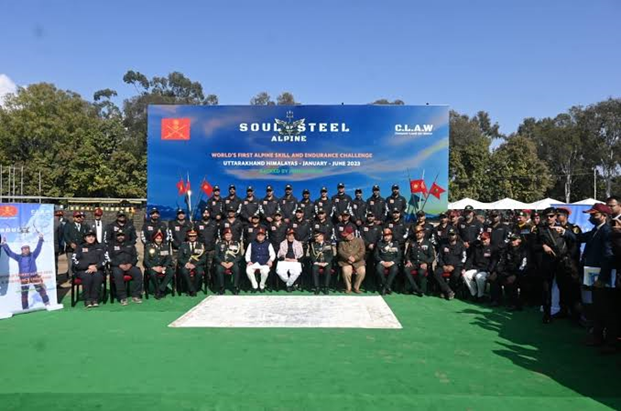
Sources: PIB.
Vishnugad Pipalkoti Hydro Electric Project:
Context:
The primary cause of the land subsidence in Joshimath is believed to be the National Thermal Power Corporation’s Tapovan Vishnugad Hydro Power Project, though climate change is also a contributing factor.
About:
- Tapovan Vishnugad Hydropower Plant is a 520 MW run-of-river hydroelectric project.
- It was constructed by National Thermal Power Corporation Limited (NTPC) on Dhauliganga River in Chamoli District of Uttarakhand.
- The power plant is located on the downstream on the Alaknanda River (one of the two headstreams of the Ganges).
Alaknanda River:
- It is one of the headstreams of the Ganga.
- It rises at the confluence and feet of the Satopanth and Bhagirath glaciers in Uttarakhand.
- It meets the Bhagirathi River at Devprayag after which it is called the Ganga.
- Its main tributaries are the Mandakini, Nandakini, and Pindar rivers.
- The Hindu pilgrimage center of Badrinath and the natural spring Tapt Kund lie along the banks of the Alaknanda River.
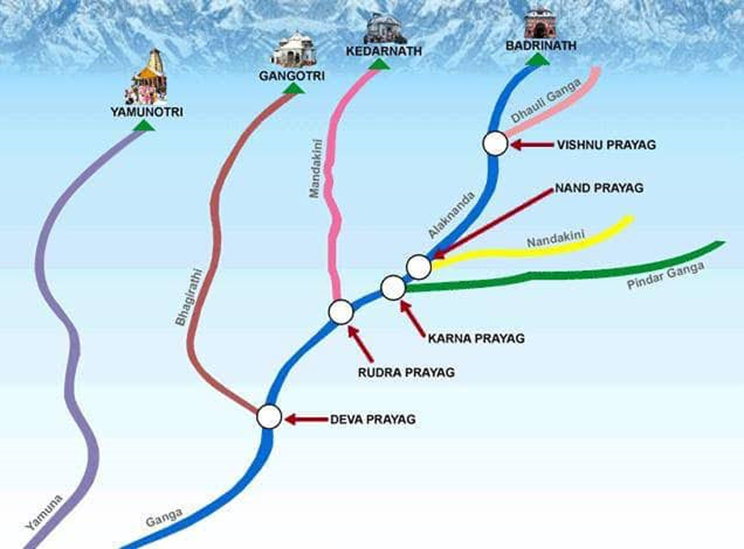
Sources: the Hindu.
1200-yr-old miniature stupas found in Nalanda district:
Patna circle of the Archeological Survey of India (ASI) has discovered two 1200-year-old miniature votive stupas near Sarai Tila mound on the premises of 'Nalanda Mahavihara', a world heritage site in Nalanda district.
- The stupas, carved from stone, depict Buddha figures.
What is a votive stupa?
Votive stupas is a form of the stupa, with its distinctive domelike drum, originates in eight cylindrical structures in which the Buddha's relics were placed after his death.
- The stupa shape has become associated with the Buddhist goal of release from the cycles of suffering and rebirth.

Source: Times of India.
MAARG portal: - Edukemy Current Affairs
Context: Commerce and industry minister will launch the MAARG platform to facilitate mentorship between startups and entrepreneurs across sectors, stages, and functions.
MAARG stands for ‘Mentorship, Advisory, Assistance, Resilience, and Growth’.
- The platform aims to connect startups with experienced industry leaders and successful entrepreneurs to provide mentorship and guidance.
- The platform will also have an online component that will allow for virtual mentoring and networking opportunities.
- The goal of the platform is to support and accelerate the growth of startups in India.
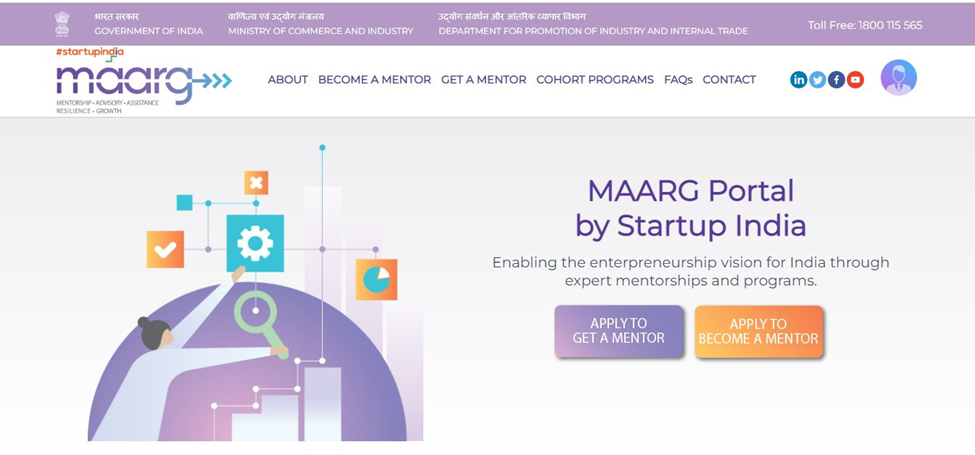
Source: Economic Times.
Hemo-halt bandage: a dressing for rapid prevention of blood loss:
Context: The scientists have prepared a biopolymer-based gel formulation and dressing in the form of ‘Hemo-halt’, as an effective and safe dressing for hemorrhage control is crucial.
- A newly developed bandage containing chitosan (a natural polymer that halts bleeding) and agonist (a substance that improves clotting) nanoparticles can rapidly minimize blood loss from wounds.
- The Hemo-halt bandage can reduce blood loss before treatment, save lives, and reduce disabilities on the battlefield.
- It can also contribute to the reduction in hospitalization costs.

Source: DST.
Kollam is India’s first Constitution literate district:
Kollam district in the Indian state of Kerala has been declared as the first "constitution literate district" in India.
- The declaration was made by the ‘Kerala State Literacy Mission Authority’ (KSLMA).
- The district has been declared "constitution literate" because of the high number of people who participated in the "constitution literacy" program run by the KSLMA.
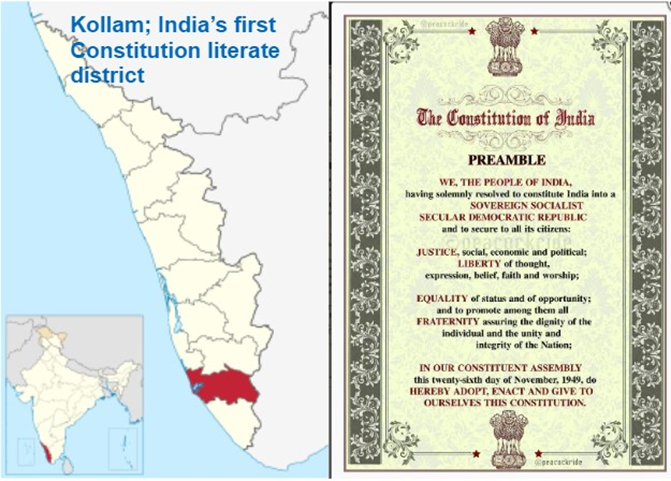
How it was done?
- A Constitution literacy campaign was jointly launched by the Kollam district panchayat, District Planning Committee and Kerala Institute of Local Administration (KILA).
- As part of the campaign, the Preamble of the Constitution was distributed in all households and installed at government, quasi-government and private institutions and schools.
- 7-month drive: During the seven-month campaign, the senators visited schools, offices, auto stands and tribal councils to spread awareness.
- 2,200 trainees: As part of the ambitious campaign, around 16.3 lakh people in the district above the age of 10 have been educated on various aspects of the Constitution and the strenuous process involved 2,200 trainers called ‘senators’.
Significance:
- Constitutional values should be integrated with life and read through the lens of fraternity.
- Dissemination of Constitutional values is important for its smooth functioning.
Source: The Hindu.
Share the article
Get Latest Updates on Offers, Event dates, and free Mentorship sessions.

Get in touch with our Expert Academic Counsellors 👋
FAQs
UPSC Daily Current Affairs focuses on learning current events on a daily basis. An aspirant needs to study regular and updated information about current events, news, and relevant topics that are important for UPSC aspirants. It covers national and international affairs, government policies, socio-economic issues, science and technology advancements, and more.
UPSC Daily Current Affairs provides aspirants with a concise and comprehensive overview of the latest happenings and developments across various fields. It helps aspirants stay updated with current affairs and provides them with valuable insights and analysis, which are essential for answering questions in the UPSC examinations. It enhances their knowledge, analytical skills, and ability to connect current affairs with the UPSC syllabus.
UPSC Daily Current Affairs covers a wide range of topics, including politics, economics, science and technology, environment, social issues, governance, international relations, and more. It offers news summaries, in-depth analyses, editorials, opinion pieces, and relevant study materials. It also provides practice questions and quizzes to help aspirants test their understanding of current affairs.
Edukemy's UPSC Daily Current Affairs can be accessed through:
- UPSC Daily Current Affairs can be accessed through Current Affairs tab at the top of the Main Page of Edukemy.
- Edukemy Mobile app: The Daily Current Affairs can also be access through Edukemy Mobile App.
- Social media: Follow Edukemy’s official social media accounts or pages that provide UPSC Daily Current Affairs updates, including Facebook, Twitter, or Telegram channels.

